First Flight, 155BJ
![]()
First Flight, 155BJ |
|
by Dave McMurray
This article appeared in the September 1994 issue of the Falco Builders Letter.
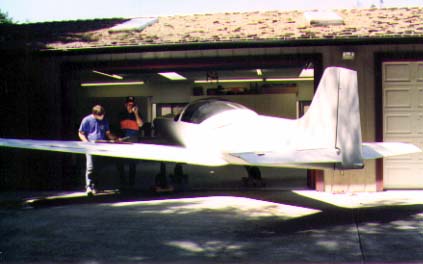
Exciting things have occurred here on the north coast of California over the last few weeks, starting with the realization that Falco 155BJ was ready to move to the airport. Due to the good working conditions we had at our shop at home, we decided to put the Falco together, including the control surfaces, and have everything rigged and ready to go. Since we have a 15-ton crane at our disposal, we figured we'd sling the Falco once we got it outside, and 'walk' it up the drive through the over-hanging redwood trees. As you can see by the pictures, it turned out to be a tight fit, but worked perfectly.
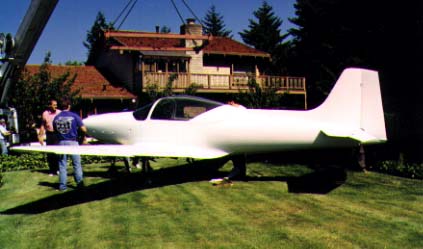
The plan was to set it down on our street lawn, (our house is 300 feet from the street) on Friday evening, then load it onto our flatbed at 4:30 Saturday morning. Needless to say, it was quite a sight to come around the corner and see the beautiful Falco perched there in all its splendor, and it created quite a stir in the neighborhood.
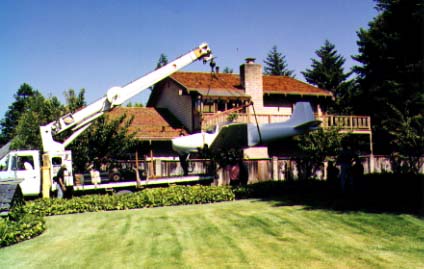
Everyone wanted to know all about the Falco and how we were going to get it to the airport. After explaining that we would be loading it early the next morning, many promised to be there to give us a hand.
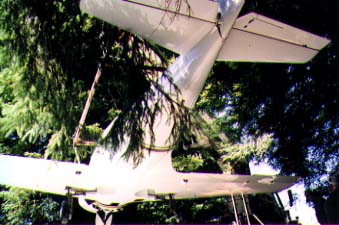
I was glued to the bird and couldn't imagine leaving it up there all by itself, so after a sleepless night in the back of my parked truck, I was up at 3:30 to prepare for the big move. We again used the spreader frame and slings with the crane, and loaded the Falco on the flatbed. The overall width was 20 feet, necessitating a permit. With an entourage of ten or more vehicles, we made the six-mile trek to the airport without a hitch.
After a breakfast celebration, the propeller was installed, and we prepared to fire the engine for the first time. We filled it to the top of the filler neck with uncompounded oil (19 quarts!) and hand-turned the propeller until we could feel compression, then drained to eight quarts. This engine had been on the floor for eight years after a High Performance Aircraft Engines rebuild. It had been kept in a heated shop, and we'd been told that it would be fine. Why eight years, you ask? Well, nine years ago I planned on building and flying the Falco within twelve to eighteen months. Anyway, it fired right up, ran smooth, and we certainly were pleased.
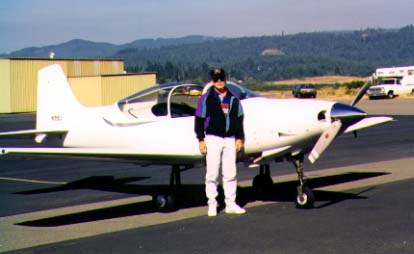
Dave McMurray and 155BJ
During the last few months, I had been pondering having a test pilot do the first flight, particularly after reading all the articles. I'd flown with Karl Hansen, Ray Purkiser and John Harns in their Falcos at the fly-ins, had some time at the controls, but realized that their planes had gone through the testing and had been proven.
John graciously volunteered to fly down to allow me some serious flight time in his, and at the same time encouraged me to consider flying it myself. After a few hours in John's beautiful bird, I decided to do the first flight. I really appreciated John's help, and the encouragement and advice that he and Karl Hansen gave me. Both were invaluable.
We waited a week for the FAA to come out, but it gave us time to go over the airframe and engine again and again. I also did the brake run-in and high-speed taxis. (Our strip is 3,000' long at 7' MSL.) The aileron response test went well, then we did the elevator test. I had my mechanic on board to call the airspeeds and off we went. Before he called 50, much to my surprise, we were airborne. This was not in the plans, and I immediately pulled power back and realigned for touchdown. Fortunately, we firmly planted it back on the runway and were pleased at the performance of the trailing link gear. They're tough!
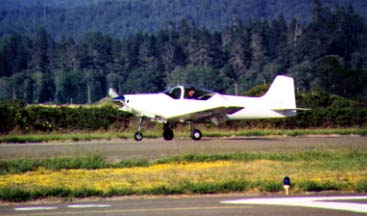
The arrival of the FAA inspector on Monday, July 25th was full of anticipation, as we planned on the first flight immediately following the certification. With the FAA's blessing, and after another high speed taxi, we were rolling. It was still hard to believe that the task that seemed would never end, had turned into a viable airframe, and it was actually doing what it was designed to do. My first task was to monitor the engine and do the break-in routine. All temperatures and oil pressure were perfect, and the first hour logged was uneventful.
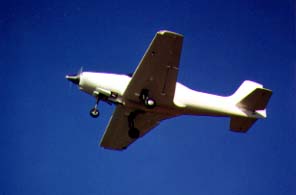
We have done four flights now, the first without gear retraction, and all without gear doors. The next flight will be with the doors and with some airspeed checks. I can honestly say that it handles like the Falcos I've flown in. It's a beautifully smooth plane to fly, and it's worth all the sawdust, sweat and tears of the last nine years.
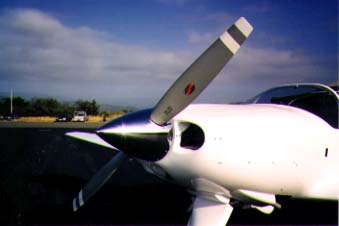
A couple of observations are in order. The high-speed taxis are important for control surface response checks, but getting airborne is not a good idea. We found our airspeed indicator in error, and we should have verified its accuracy before doing the tests. I don't think the chances of bending the bird are worth the few seconds of flight. The fact is, this plane will come off quickly under full power with the elevator in the full-up position, and the nose does come up almost immediately. My few seconds' delay in reducing power was all it took and the distraction of getting airborne could have caused serious problems. Alfred, you've got it right in your guide. I read and re-read it before testing, but it happened so quickly.
I know the recommendation is to let a test pilot do the first flight, and it may be the right way in most instances. Time spent flying a Falco before the decision is made is important. An evaluation by one of the more skilled Falco jocks, (in my case, John Harns and Karl Hansen) should be imperative before the first flight.
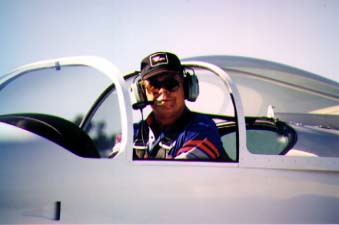
Dave McMurray